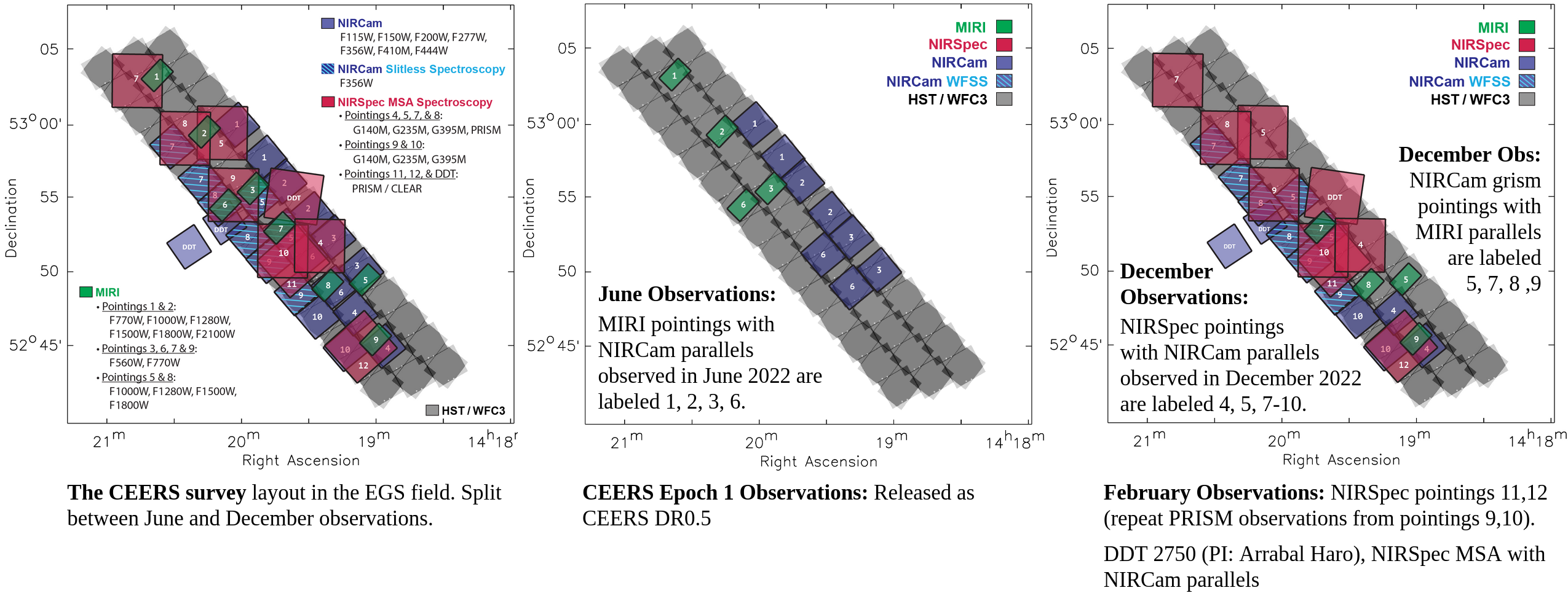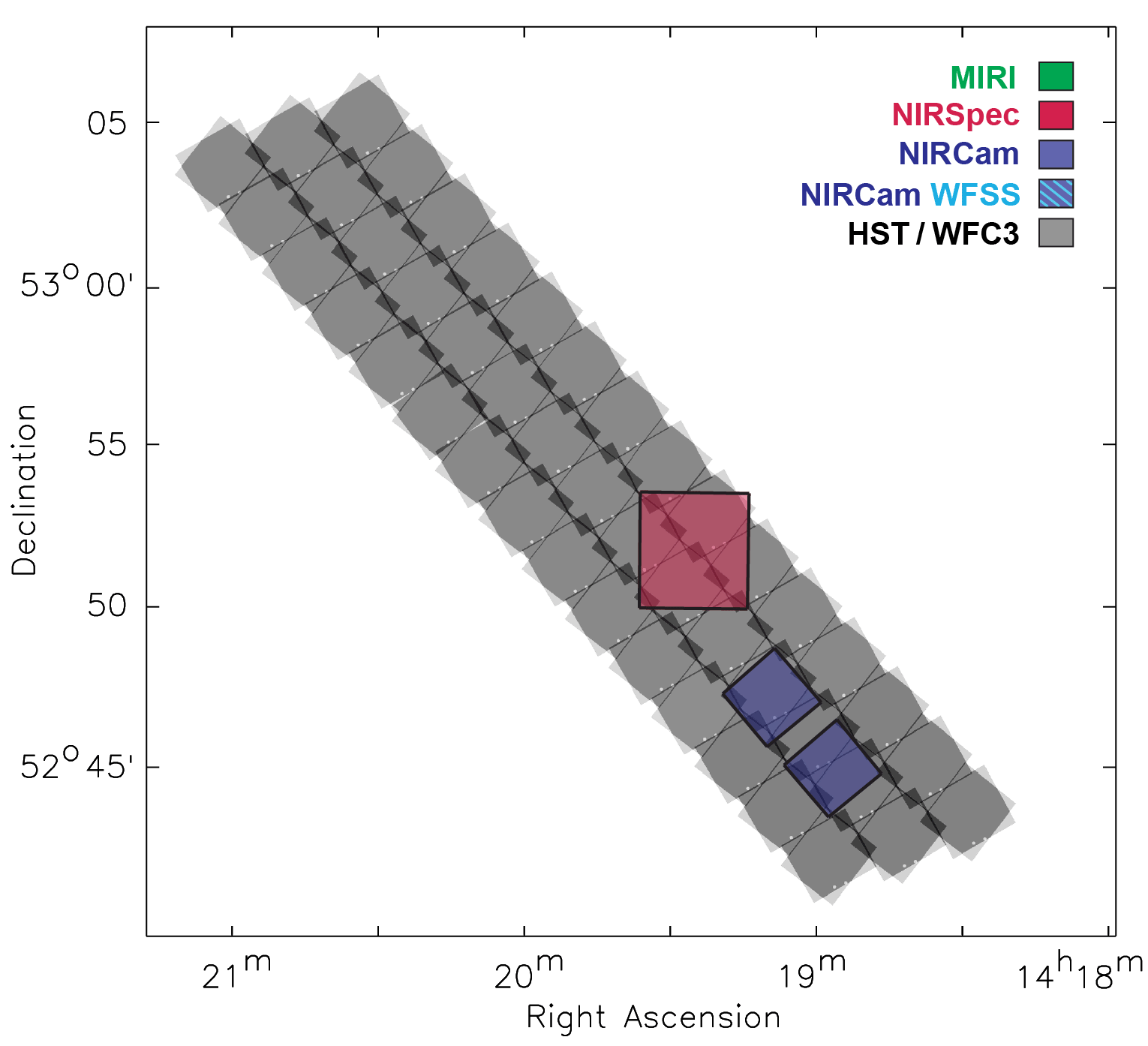CEERS Observing Modes
CEERS has obtained imaging and spectroscopy of the Extended Groth Strip (EGS) HST legacy field with three JWST instruments and five prime-parallel observing mode combinations.
CEERS has obtained imaging and spectroscopy of the Extended Groth Strip (EGS) HST legacy field with three JWST instruments and five prime-parallel observing mode combinations.
CEERS consists of 10 pointings of prime+parallel instrument combinations, obtained in three epochs in 2022-2023. The observations were highly constrained in order to maximize overlap between JWST instruments and with the existing HST imaging in the field. The pointings were schedulable in June and December (with a 180° flip), and aspects of the survey were redesigned multiple times in response to changes in the observing schedule, the opportunity to follow up newly discovered exciting targets, and the need to repeat a handful of observations. As a result, the final CEERS survey layout is a bit chaotic, and so we describe it in detail here with survey layout maps and a table of all pointings.
Three epochs of observations
At the end of commissioning, there was not enough time left in the CEERS June observing window to complete the entire survey. The first four imaging pointings (MIRI + NIRCam) were observed in June 2022. The remaining six NIRSpec MSA + NIRCam imaging and four NIRCam grism + MIRI imaging pointings were observed in December 2022. Following a short in the MSA that affected two NIRSpec PRISM observations, we obtained two additional PRISM reobservations in February 2023. You can access all CEERS observations on MAST.
We show here the complete survey layout (left), separating the June observations (middle) and the December/February observations (right). We also include the DDT NIRSpec follow-up of Maisie's Galaxy led by Pablo Arrabal Haro (DDT 2750).


Here we show the survey layout separated by instrument, with NIRCam imaging and WFSS (left), MIRI imaging (middle) and NIRSpec MSA PRISM and medium gratings (right). We again include the DDT NIRSpec follow-up of Maisie's Galaxy led by Pablo Arrabal Haro (DDT 2750).


Finally, here is an animated GIF building the CEERS survey layout up pointing by pointing. This animation helps show which primary and parallel pointings are related. Images and GIF courtesy of Dale Kocevski.

CEERS Pointings
| ID | Primary Observation | Parallel Observation | Epoch of Observation |
|---|---|---|---|
| 1 | MIRI Imaging (6 filters, 7-21 μm) | NIRCam Imaging (7 filters, 1-5 μm) | Epoch 1, June 2022 |
| 2 | MIRI Imaging (6 filters, 7-21 μm) | NIRCam Imaging (7 filters, 1-5 μm) | Epoch 1, June 2022 |
| 3 | MIRI Imaging (2 filters, 5-7 μm) | NIRCam Imaging (7 filters, 1-5 μm) | Epoch 1, June 2022 |
| 4 | NIRSpec MSA (G140M, G235M, G395W, PRISM) | NIRCam Imaging (7 filters, 1-5 μm) | Epoch 2, Dec 2022 |
| 5 | NIRSpec MSA (G140M, G235M, G395W, PRISM) NIRCam WFSS F356W (+F115W Imaging) |
NIRCam Imaging (7 filters, 1-5 μm) MIRI Imaging (4 filters, 10-18 μm) |
Epoch 2, Dec 2022 |
| 6 | MIRI Imaging (2 filters, 5-7 μm) | NIRCam Imaging (7 filters, 1-5 μm) | Epoch 1, June 2022 |
| 7 | NIRSpec MSA (G140M, G235M, G395W, PRISM) NIRCam WFSS F356W (+F115W Imaging) |
NIRCam Imaging (7 filters, 1-5 μm) MIRI Imaging (2 filters, 5-7 μm) |
Epoch 2, Dec 2022 |
| 8 | NIRSpec MSA (G140M, G235M, G395W, PRISM) NIRCam WFSS F356W (+F115W Imaging) |
NIRCam Imaging (7 filters, 1-5 μm) MIRI Imaging (4 filters, 10-18 μm) |
Epoch 2, Dec 2022 |
| 9 | NIRSpec MSA (G140M, G235M, G395W, PRISM*) NIRCam WFSS F356W (+F115W Imaging) |
NIRCam Imaging (7 filters, 1-5 μm) MIRI Imaging (2 filters, 5-7 μm) |
Epoch 2, Dec 2022 |
| 10 | NIRSpec MSA (G140M, G235M, G395W, PRISM*) | NIRCam Imaging (7 filters, 1-5 μm) | Epoch 2, Dec 2022 |
| 11 | NIRSpec MSA (PRISM) | -- | Epoch 3, Feb 2023 |
| 12 | NIRSpec MSA (PRISM) | -- | Epoch 3, Feb 2023 |
* A short in the MSA affected the PRISM observations of pointings 9 and 10. These observations were repeated in Epoch 3, and the pointings were shifted to cover high-priority targets discovered in the Epoch 2 NIRCam imaging.
Click below to download a zipped file containing NIRCam, NIRSpec and MIRI pointing maps. These maps are approximate, good to within ~10". (Note that the NIRSpec pointing maps do not include pointings 11 and 12.)
Download June pointing maps
Download December pointing maps
Download full survey pointing maps
Imaging in 10 pointings
The NIRCam imaging observing strategy is set by the primary science goal of detecting a large sample of z~9-13 galaxies. F115W + F150W + F200W probe the Lyα break and are paired with the LW filters F277W, F356W, F410M and F444W. We used exposure times of ~3000 s in all filters, with approximately double the exposure time in F115W to increase the dynamic range of detectable detectable Lyα breaks. F410W also acts as a narrow-band filter for [OIII] emission at 6.7 < z < 7.6.
The following represent the median 5σ point source depths per filter in all 10 pointings:
| SW Filter | Depth (5σ pt. source) |
LW Filter | Depth (5σ pt. source) |
|---|---|---|---|
| F115W | 29.20 | F277W | 29.15 |
| F150W | 29.00 | F356W | 29.15 |
| F200W | 29.16 | F410M | 28.32 |
| F444W | 28.54 |
Wide Field Slitless Spectroscopy in 4 pointings
The WFSS observations use the F356W filter (~3.1-4 μm) with exposure times of ~3000s split between the row (R) and column (C) NIRCam grisms (R~1500). The CEERS grism observations probe Hα at 3.7 > z > 5.1, [OIII] at 5.3 > z > 7.0, and [OII] at 7.3 > z > 9.7. They also provide spatial maps of emission in a variety of extended targets. The pointings partially overlap 3 CEERS NIRSpec pointings, providing an opportunity to calibrate NIRSpec slit losses.
The NIRSpec MSA observations address diverse goals: measuring redshifts of high-priority distant galaxies, characterizing ISM and AGN evolution, and testing JWST observing strategies for Cycle 2. CEERS observed 6 pointings with three medium gratings (G140M/F100LP, G235M/F170LP and G395M/F290LP; R~1000) and 4 pointings with the PRISM (R~100). Two of the PRISM pointings were affected by an MSA short in December and were repeated at new positions in February, 2023. The NIRSpec strategy includes:
Click below to download the list of objects which received NIRSpec MSA slits in our original Aug 2017 APT submission. This is just one realization of what the final configuration will be, but it gives a rough idea of the numbers of which types of sources will receive slits.
The MIRI observations cover 8 pointings with two different strategies. In the pointings overlapping the NIRCam mosaic, we aim for 5σ detections of the highest–redshift candidates in F560W and F770W, achieving long-wavelength constraints on z=4-10 candidate SEDs. In the remaining pointings, we use the continuous wavelength coverage of F770W, F1000W, F1280W, F1500W, F1800W and F2100W to study the rest-mid-IR features of galaxies, providing contraints on star formation rate and AGN diagnostics at z=1-3.
The following represent the median 5σ point source depths per filter and the filter coverage in each pointing:
| Filter | Depth (5σ pt. source) |
Pointing |
|---|---|---|
| F560W | 26.1 | 3, 6, 7, 9 |
| F770W | 25.6 | 1, 2, 3, 6, 7, 9 |
| F1000W | 24.8 | 1, 2, 5, 8 |
| F1280W | 23.9 | 1, 2, 5, 8 |
| F1500W | 23.4 | 1, 2, 5, 8 |
| F1800W | 22.6 | 1, 2, 5, 8 |
| F2100W | 22.3 | 1, 2 |